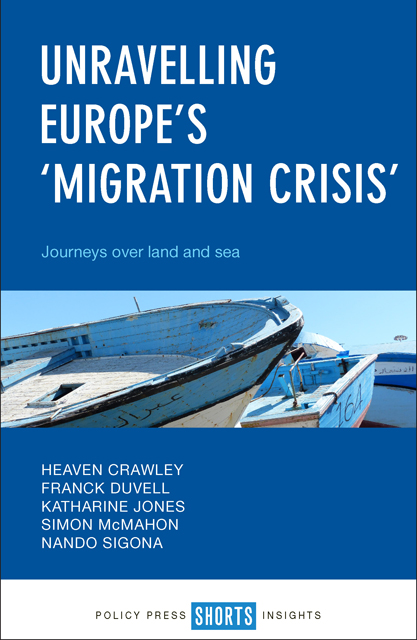Book contents
- Frontmatter
- Contents
- List of figures
- List of boxes
- Acronyms
- Notes on the authors
- Acknowledgements
- Foreword by Joanne Liu
- one The view from Europe
- two Unravelling Europe’s ‘migration crisis’
- three Not one route but many: unpacking migration to Europe
- four The decision to leave
- five Navigating borders and danger: the use of smugglers
- six Moving on
- seven Across the sea… and beyond
- eight Rethinking Europe’s response
- References
- Index
eight - Rethinking Europe’s response
Published online by Cambridge University Press: 21 April 2023
- Frontmatter
- Contents
- List of figures
- List of boxes
- Acronyms
- Notes on the authors
- Acknowledgements
- Foreword by Joanne Liu
- one The view from Europe
- two Unravelling Europe’s ‘migration crisis’
- three Not one route but many: unpacking migration to Europe
- four The decision to leave
- five Navigating borders and danger: the use of smugglers
- six Moving on
- seven Across the sea… and beyond
- eight Rethinking Europe’s response
- References
- Index
Summary
We conclude by examining the EU’s response to increased migration in 2015 as well as policy developments in 2016 and early 2017. As noted in Chapter Two, the late, chaotic and uncoordinated nature of the response was not simply a consequence of the large numbers of people arriving. Migration across the Mediterranean, while larger in scale than anything seen previously, was small when compared with the scale of displacement elsewhere, most notably in countries neighbouring Syria (Turkey, Lebanon and Jordan), the population of the EU1 and the relative wealth of the 28 EU Member States. The ‘migration crisis’ was simply the lens through which a number of other issues came to be viewed and arguably magnified.
Moreover, the findings of our research lead us to conclude that the EU and individual Member States contributed to the ‘crisis’ because their response was based on a series of flawed assumptions about the dynamics of migration across the Mediterranean. As the voices and experiences of the refugees and migrants presented in this book have shown, the nature of journeys, the routes taken and the factors that led people to get on a boat to Europe were far more complex than was typically presented. While the EU was successful, eventually, in reducing the number of arrivals through the Eastern Mediterranean route, it has done little to address the factors that led people to leave their homes in the first place or to move on from the places in which they initially settled. Addressing these factors will require a much more nuanced, longer-term approach.
The ‘migration crisis’ in context
So much attention has been paid to Europe’s ‘migration crisis’ as a problem of numbers and scale that there has been a tendency to overlook the fact that this was just one facet of a trajectory of multiple crises (Kjaer and Olsen, 2016; Chryssogelos, 2016; Drozdiak, 2017) (Box 8.1). The crisis began not in 2015 but back in 2008 with a global financial crisis which triggered the European financial and debt crisis associated with far-reaching austerity policies. This had already affected the social order and undermined social coherence and trust in the European project which successively reinvigorated right-wing and populist political movements and parties.
- Type
- Chapter
- Information
- Unravelling Europe's 'Migration Crisis'Journeys Over Land and Sea, pp. 129 - 156Publisher: Bristol University PressPrint publication year: 2017



